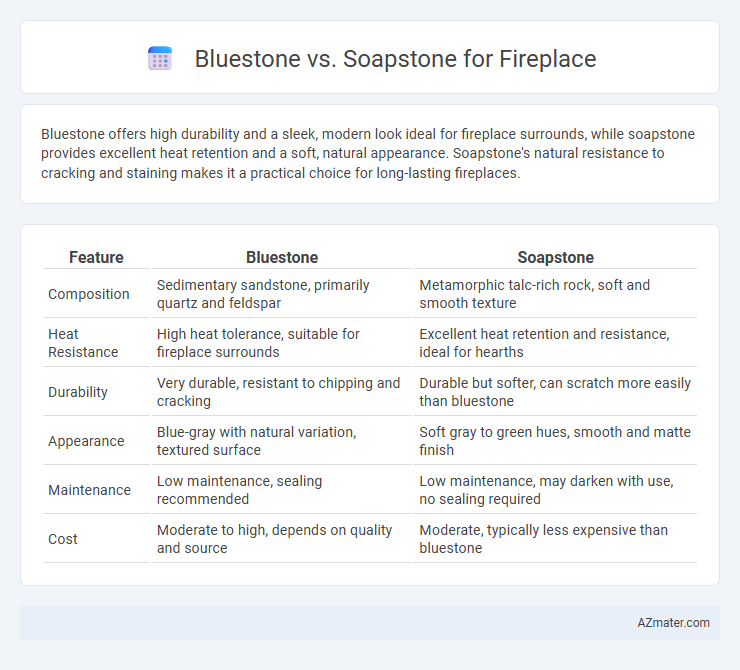Bluestone offers high durability and a sleek, modern look ideal for fireplace surrounds, while soapstone provides excellent heat retention and a soft, natural appearance. Soapstone's natural resistance to cracking and staining makes it a practical choice for long-lasting fireplaces.
Table of Comparison
| Feature | Bluestone | Soapstone |
|---|---|---|
| Composition | Sedimentary sandstone, primarily quartz and feldspar | Metamorphic talc-rich rock, soft and smooth texture |
| Heat Resistance | High heat tolerance, suitable for fireplace surrounds | Excellent heat retention and resistance, ideal for hearths |
| Durability | Very durable, resistant to chipping and cracking | Durable but softer, can scratch more easily than bluestone |
| Appearance | Blue-gray with natural variation, textured surface | Soft gray to green hues, smooth and matte finish |
| Maintenance | Low maintenance, sealing recommended | Low maintenance, may darken with use, no sealing required |
| Cost | Moderate to high, depends on quality and source | Moderate, typically less expensive than bluestone |
Introduction to Fireplace Stone Options
Bluestone and soapstone are popular fireplace stone options known for their durability and heat resistance. Bluestone offers a dense, fine-grained surface with a natural blue-gray hue, while soapstone is prized for its smooth texture and superior heat retention. Both stones enhance fireplace aesthetics and functionality, making them practical choices for heat-efficient, long-lasting hearth designs.
Bluestone Overview: Characteristics and Appeal
Bluestone is a dense, durable natural stone known for its smooth texture and rich blue-gray hues, making it a popular choice for fireplace surrounds. Its excellent heat resistance and ability to retain warmth contribute to both functional and aesthetic appeal in fireplace design. The stone's timeless color variations and fine-grain composition offer a sophisticated, elegant look that enhances any interior space.
Soapstone Overview: Qualities and Benefits
Soapstone is a dense, heat-retentive metamorphic rock prized for its excellent thermal conductivity and ability to evenly distribute heat, making it an ideal material for fireplaces. Its natural resistance to cracking and thermal shock, combined with a smooth, non-porous surface that ages gracefully, ensures durability and long-lasting performance. The unique aesthetic of soapstone, characterized by its soft gray tones and subtle veining, enhances fireplace design while providing efficient heat retention that continues to radiate warmth long after the fire has died down.
Heat Retention and Distribution
Bluestone offers moderate heat retention with quick heat-up times, making it suitable for fireplaces that need rapid warmth. Soapstone excels in heat retention and even heat distribution due to its dense composition, maintaining warmth for hours after the fire has died down. Choosing between bluestone and soapstone depends on whether you prioritize fast heating or prolonged, consistent heat release.
Durability and Longevity Comparison
Bluestone and soapstone both offer excellent durability for fireplaces, but soapstone is generally more resistant to heat and thermal shock, ensuring longer-lasting performance. Bluestone, while hard and dense, may be more prone to chipping or cracking under extreme temperature changes compared to the more heat-tolerant soapstone. Soapstone's superior ability to absorb and radiate heat evenly also contributes to its longevity, making it a preferred choice for fireplace applications where durability is crucial.
Maintenance Requirements and Care
Bluestone fireplaces require minimal maintenance with occasional sealing to prevent staining and preserve their natural color, making them relatively easy to care for. Soapstone, known for its durability and heat retention, demands less frequent sealing but benefits from regular cleaning with mild soap and water to maintain its smooth, non-porous surface. Both materials resist heat well, but soapstone's resistance to cracking and its ability to darken gracefully over time offer added advantages in long-term fireplace care.
Aesthetic Differences and Design Choices
Bluestone fireplaces exhibit a smooth, cool blue-gray hue with subtle veining that complements modern and minimalist interiors, while soapstone features softer, muted tones ranging from greenish-gray to brown with a naturally variegated texture ideal for rustic or traditional designs. The dense, non-porous nature of bluestone offers a polished, contemporary finish that enhances sleek architectural styles, contrasting with soapstone's matte surface that ages gracefully and develops a warm patina over time. Design choices hinge on bluestone's clean, uniform appearance for streamlined aesthetics versus soapstone's tactile, organic character that provides a cozy, inviting ambiance.
Cost Analysis: Bluestone vs Soapstone
Bluestone fireplaces typically cost between $30 to $50 per square foot, offering a more affordable option compared to soapstone, which ranges from $50 to $90 per square foot due to its denser composition and heat retention properties. Installation costs for bluestone are generally lower since it is easier to cut and shape, whereas soapstone requires specialized labor, increasing overall expenses. Long-term, soapstone's durability and superior heat retention may offset initial higher costs by enhancing energy efficiency and reducing heating bills.
Environmental Impact and Sourcing
Bluestone is typically quarried in the northeastern United States, often resulting in less transportation-related carbon emissions compared to soapstone, which is sourced mainly from Finland, Brazil, and India. Soapstone, composed primarily of talc and magnesium, offers durability and heat retention but involves mining processes that can have significant environmental impact due to habitat disruption and energy use. Bluestone's more localized extraction and lower embodied energy make it a generally more environmentally sustainable option for fireplaces, aligning with eco-conscious building practices.
Choosing the Right Stone for Your Fireplace
Bluestone offers exceptional durability and a sleek blue-gray color that complements modern fireplace designs, making it ideal for high-heat environments. Soapstone features a softer texture with excellent heat retention, releasing warmth slowly and providing a rustic aesthetic. Selecting the right stone depends on balancing thermal performance with desired visual appeal and maintenance needs.

Infographic: Bluestone vs Soapstone for Fireplace
 azmater.com
azmater.com